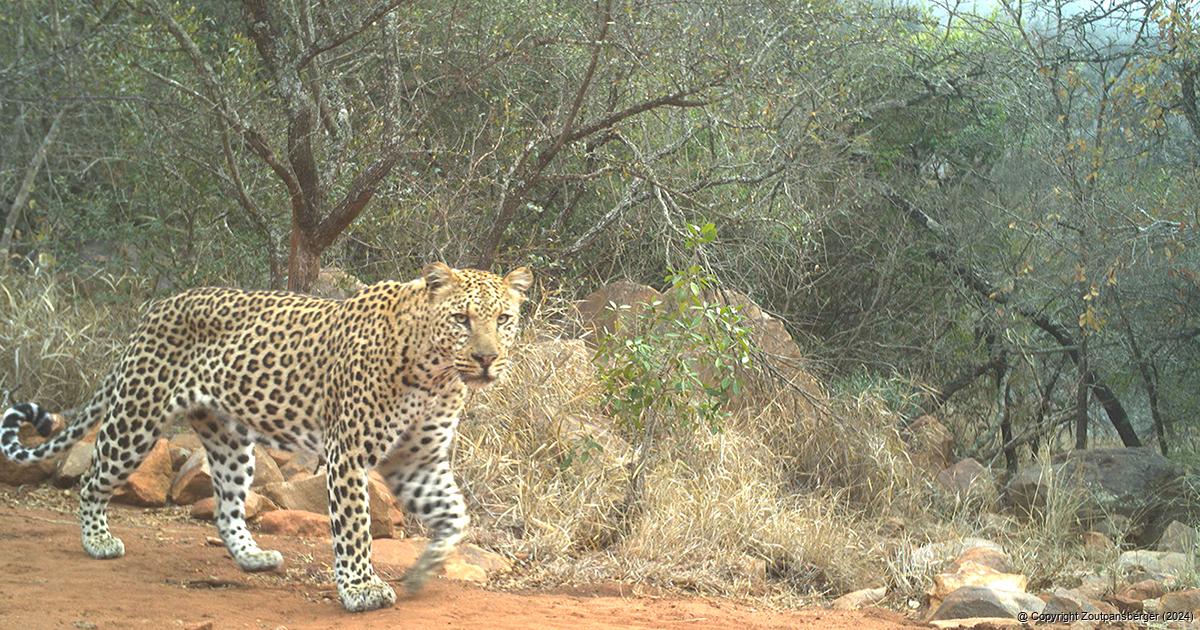

ADVERTISEMENT:

Leopards were photographed at nearly 80% of the camera-trap stations in the western Soutpansberg, and the analysis estimated the 2023 population density at 4.7 leopards per 100km², a decrease from the 2022 estimate of 7.2 leopards per 100km². Photo: Primate and Predator Project.
Decline in Soutpansberg’s leopard population concerning
Date: 18 January 2024 By:
Nature Conservation
In March 2023, a leopard was sighted crossing the N1 from the Komatiland plantation into Louis Trichardt’s suburbs. While this came as a surprise to many, leopards are not uncommon in the Soutpansberg.
For over a decade, Durham University’s Primate and Predator Project has monitored the leopard population within the western Soutpansberg, using a permanent camera-trapping grid that observes the leopard population and other species in the mountains. “Although the population has significantly declined since the initial surveys in 2008, numbers had stabilised, and a reasonable leopard population lives in the mountains. Leopards generally avoid humans but may move close to areas of human habitation when traveling between preferred habitats,” said Professor Russell Hill from the Department of Anthropology at Durham University (UK) and adjunct professor in the Department of Biological Sciences at Univen.
At the time of the 2023 sighting, the Primate and Predator Project was conducting its 10th annual survey for the South African Leopard Monitoring Project as part of a long-term collaboration with Panthera. The project aims to provide robust data on leopard-population trends in South Africa to inform conservation policy and management. The survey covered multiple properties in the western Soutpansberg, with 39 camera-trap stations covering a total area of around 178km². Leopards were photographed at nearly 80% of the stations, and the analysis estimated the 2023 population density at 4.7 leopards per 100km², a decrease from the 2022 estimate of 7.2 leopards per 100km². “Although the survey showed relative stability in the population structure and sex ratio of adult males to females, the significant decline is concerning for the long-term viability of the population,” said Hill.
Leopards are considered vulnerable according to the South African Biodiversity Institute’s 2016 Regional Red List status and face multiple threats to their conservation. “Continual long-term monitoring of the leopard population in the western Soutpansberg will be essential to further understand the state and stability of this important population,” said Hill.
Currently, the Primate and Predator Project is gearing up to commence the 2024 survey in March and will provide further updates on the population status later in the year.
Viewed: 1976
|
|
Tweet |

-

Bekende akademikus verloor stryd teen kanker
26 April 2024 By Andries van Zyl -

Ystervrou van die Bosveld oorlede
26 April 2024 By Pétria de Vaal -

Arrestasie ná boere dreig om te skiet
26 April 2024 By Andries van Zyl -

Yahya selected for SA over-50s World Cup
26 April 2024 By Anton van Zyl -

Wetteloosheid op paaie wys die krake in plaaslike wetstoepassing
25 April 2024 By Andries van Zyl


More photos...

ADVERTISEMENT


-

MMSEZ now also looking at nuclear power
19 April 2024 By Andries van Zyl -

Former Triegie’s acting career taking off
12 April 2024 By Karla van Zyl -

Local para-athletes shine at SA Champs
05 April 2024 -

Woede ná R524 nog ‘n lewe eis
19 April 2024 By Andries van Zyl -

Border fence contractors lose appeal
18 April 2024

ADVERTISEMENT:


ADVERTISEMENT


